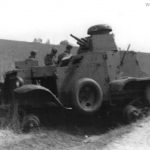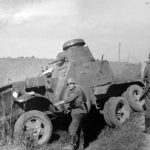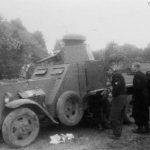BA-27 car
BA-27M
BA-27M
BA-27M
The BA-27 was a Soviet medium armoured vehicle of the 1930s. The first serial armoured vehicle of the USSR. The world’s first serial three-axle specialised fighting vehicle. It was developed on the chassis of the 1.5 ton AMO-F-15 truck, copy of the Fiat F-15, in 1927 to replace the obsolete armoured vehicles of the Red Army. It was mass-produced in 1928-1931, 215 vehicles were built in total.
In early 1927, A. Rozhkov, member of the Artillery Committee (Artkom) of the Red Army Artillery Directorate (AU), was commissioned to design an armoured vehicle on the chassis of the first Soviet one and a half tonne AMO-F-15 truck.
Installation of the armoured body required some modifications to the standard chassis. At Rozhkov’s request, AMO designers under the direction of engineers B. D. Strokanov and E. I.Vazhinsky designed the chassis AMO F-15 SP (special): reinforced springs and frame, increased angle of inclination of the steering column, redesigned front control pedals, gear shift levers and brakes, installed rear control post. In the summer of 1927 the experimental chassis underwent sea trials in the vicinity of Moscow.
In Autumn Rozhkov completed the drawings of the armoured hull, after which a group of engineers of the state armoured vehicle design bureau headed by V. Zaslavsky finalised the project. The armoured vehicle was designated B-27.
The prototype armoured hull was produced at Izhorskiy Zavod and delivered to the AMO plant in Moscow at the beginning of 1928 to be fitted to the chassis.
On March 24-31, 1928 a specially appointed commission of the Artillery Directorate of the Red Army conducted tests of the prototype. On March 27th the armoured vehicle was taken to the Kuntsev proving ground of the Higher Rifle School, where weapons testing was conducted by target shooting. On 31st March the prototype made a short test drive, after which it was taken to the factory for inspection of the vehicle’s components. The report of the test commission was sent to the chiefs of the Artillery Directorate and the supply department of the Red Army. Most members of the commission gave the B-27 a favourable rating, while at the same time suggesting the following refinements: arm the assistant driver and rear driver with submachine guns, improve the cooling of the machine guns to increase the duration of continuous firing, improve the ball machine gun mount and equip the machine gun and cannon with telescopic sights.
By June 1928 some changes had been made to the armoured hull: turret hood began to open backwards for easier observation of the terrain; shutters in the radiator protection armour plates were replaced by removable armour plates, which were attached to the sides of the hull in the marching position; large searchlight was replaced by a smaller internal searchlight with a hinged cover; smaller diameter headlights without armor plates were installed; armour scheme is modified to allow removal of the engine without removal of the hull; fuel line is split into two lines and driver’s seat were raised by 50 mm.
On October 24, 1927 by decision of the Revolutionary Military Council of the USSR the armored vehicle was adopted by Red Army under the designation of BA-27. Production was assigned to Izhorsky factory, chassis was supplied by AMO factory.
In spring 1930 one armoured vehicle of the second batch was sent to 2nd vehicle assembly plant KIM in Moscow, which was assembling Ford-AA vehicles arriving from the USA. The armored body of BA-27 was installed on a slightly upgraded Ford-AA chassis (in particular, the angle of steering column was changed). The tests showed that due to more powerful engine the speed and range of the armored vehicle was increased. Wider wheel track significantly increased stability (allowable side roll increased up to 15 degrees) – this solved the problem of side tipping of the narrow and tall, on a standard chassis AMO-F-15SP, BA-27. But in connection with beginning of designing of new types of medium armoured vehicles on three-axis chassis Ford-Thimken, mass re-installation of BA-27 on Ford-AA chassis was considered unreasonable.
In the summer of 1931 the production of armoured vehicles was stopped. Only 86 out of 105 ordered BA-27s of third batch were made. Production of the fourth batch was not started. Total production of BA-27 for 1928-1931 215 armoured vehicles, including a prototype.
BA-27ZD
In the mid-1930s, the Red Army’s Armoured Vehicles Department decided to adapt the obsolete and decommissioned BA-27 armoured vehicles for railway transportation. In 1936 two vehicles were rebuilt in the workshops of military depot No 60 in Bryansk. The vehicles were equipped with railroad wheels and a jack with a pivoting device, which was used to move the vehicle onto the rails. Also in the stern of the machines a buffer and coupling device was installed, which allowed to attach the machine to the end car of the train or connect two machines to each other. The front and rear springs were locked in place with clamps when the vehicle was in motion on the rails. This version received designation BA-27ZD. The prototypes were successfully tested in 1937 in the 2nd regiment of armored trains. Speed on rails was 50 km/h. Since 1938 it was planned to convert all BA-27s to armoured trains, but the program was not fulfilled.
BA-27M
In the second half of the 1930s the question arose about the fate of the BA-27 armoured vehicles – production of these had ceased as early as 1931, and there was insufficient production of spare parts for them. As a result, by 1936, most of the B-27s were in need of repair.
In July, 1937, at armoured repair depot No.2 an armoured hull of BA-27 was mounted on three-axle chassis GAZ-AAA (wheel arrangement 6×4). The new vehicle was designated as BA-27M.
In the process of modernization, the rear control compartment was dismantled, and an extra fuel tank was installed aft, so the total tank capacity reached 150 litres. Thickness of main armour plates is brought to 8 mm. It was equipped with a four-speed gearbox with demultiplier; dependent suspension consisting of transverse semi-elliptic leaf spring with torque rods on the front axle and longitudinal semi-elliptic leaf springs with torque rods on the second and third axles; mechanical brakes on the front wheels and hydraulic brakes on the rear wheels. The spare wheels were mounted along the sides of the hull and were fitted with a pivoting hub to allow the vehicle to negotiate bumps, escarpments and other obstacles to prevent damage to the underside of the frame. To increase all-terrain mobility, the tyres of rear bogie were fitted with the “overall” type track.
The BA-27M was superior to the BA-27 in cross-country ability and manoeuvrability, being able to climb gradients of up to 23°, compared with 15° of the BA-27. Its weight increased to 4.5 tonnes, highway speed increased to 48 km/h. Increase of fuel tanks’ capacity gave the vehicle maximum cruising range up to 415 km.
After the tests ABTU RKKA decided to modernise all existing BA-27s for use in reconnaissance battalions of infantry divisions (8 vehicles each) which experienced a great shortage of armoured vehicles. The works were carried out at the armoured repair base № 2 in Mitkovo, which was allocated an additional number of GAZ-AAA chassis. Complete conversion of BA-27 to BA-27M was completed by the end of 1938.
Several BA-27Ms stayed in service of reconnaissance battalions of infantry divisions instead of the standard BA-6 and BA-10. Approximately 170 BA-27s were still in service on the eve of World War II. Most of the vehicles in the frontier units were lost in the first weeks of the war. By the end of the summer 1941 the surviving BA-27Ms were transferred from the reconnaissance battalions of infantry divisions to training units or to Osoaviachim.
But due to huge losses in equipment in autumn 1941 BA-27s were used even in tank units. A number were captured by Germany and pressed into service. Eight BA-27s were exported to Mongolia in 1930.
Source:
Jamie Prenatt: SOVIET ARMOURED CARS 1936–45, Osprey NEW VANGUARD 284
AFV Weapons Profile 60 – Russian Armoured Cars (to 1945)
James Kinnear: Russian Armored Cars 1930-2000



